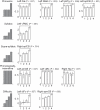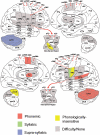Distinct representations of phonemes, syllables, and supra-syllabic sequences in the speech production network
- PMID: 20035884
- PMCID: PMC2840383
- DOI: 10.1016/j.neuroimage.2009.12.065
Distinct representations of phonemes, syllables, and supra-syllabic sequences in the speech production network
Abstract
Functional neuroimaging studies have converged on a core network of brain regions that supports speech production, but the sublexical processing stages performed by the different parts of this network remain unclear. Using an fMRI adaptation paradigm and quantitative analysis of patterns of activation rather than contrast subtractions alone, we were able to identify a set of neural substrates predominantly engaged in phonemic, syllabic, and supra-syllabic levels of processing during speech. Phoneme-level processes were found in the left SMA, pallidum, posterior superior temporal gyrus, and superior lateral cerebellum. Syllable-level processes were found in the left ventral premotor cortex, and supra-syllabic processes related to phonological chunking were found in the right superior lateral cerebellum. Active regions that were not sensitive to sublexical manipulations included primary motor and auditory cortical areas, and medial cerebellum. These results offer a quantitative technique for localizing sublexical neural processes that are difficult to dissociate using non-invasive imaging techniques and provide the beginnings of a "brain map" for language output.
Keywords: SMA; fMRI; premotor cortex; speech.
Copyright 2009 Elsevier Inc. All rights reserved.
Figures





Similar articles
-
Distinct representations of syllables and phonemes in Chinese production: Evidence from fMRI adaptation.Neuropsychologia. 2015 Oct;77:253-9. doi: 10.1016/j.neuropsychologia.2015.08.027. Epub 2015 Aug 31. Neuropsychologia. 2015. PMID: 26334943
-
Phonological manipulation between speech perception and production activates a parieto-frontal circuit.Neuroimage. 2012 Jan 2;59(1):788-99. doi: 10.1016/j.neuroimage.2011.07.025. Epub 2011 Jul 21. Neuroimage. 2012. PMID: 21787870
-
Neural correlates of sublexical processing in phonological working memory.J Cogn Neurosci. 2011 Apr;23(4):961-77. doi: 10.1162/jocn.2010.21491. Epub 2010 Mar 29. J Cogn Neurosci. 2011. PMID: 20350182 Free PMC article.
-
Stimulus-dependent activations and attention-related modulations in the auditory cortex: a meta-analysis of fMRI studies.Hear Res. 2014 Jan;307:29-41. doi: 10.1016/j.heares.2013.08.001. Epub 2013 Aug 11. Hear Res. 2014. PMID: 23938208 Review.
-
Speech Computations of the Human Superior Temporal Gyrus.Annu Rev Psychol. 2022 Jan 4;73:79-102. doi: 10.1146/annurev-psych-022321-035256. Epub 2021 Oct 21. Annu Rev Psychol. 2022. PMID: 34672685 Free PMC article. Review.
Cited by
-
Structural correlates of spoken language abilities: A surface-based region-of interest morphometry study.Brain Lang. 2015 Oct;149:46-54. doi: 10.1016/j.bandl.2015.06.004. Epub 2015 Jul 14. Brain Lang. 2015. PMID: 26185048 Free PMC article.
-
Computational neuroanatomy of speech production.Nat Rev Neurosci. 2012 Jan 5;13(2):135-45. doi: 10.1038/nrn3158. Nat Rev Neurosci. 2012. PMID: 22218206 Free PMC article. Review.
-
Lexicality-Modulated Influence of Auditory Cortex on Subthalamic Nucleus During Motor Planning for Speech.Neurobiol Lang (Camb). 2023 Jan 18;4(1):53-80. doi: 10.1162/nol_a_00086. eCollection 2023. Neurobiol Lang (Camb). 2023. PMID: 37229140 Free PMC article.
-
Lateralization and Time-Course of Cortical Phonological Representations during Syllable Production.eNeuro. 2023 Oct 6;10(10):ENEURO.0474-22.2023. doi: 10.1523/ENEURO.0474-22.2023. Print 2023 Oct. eNeuro. 2023. PMID: 37739786 Free PMC article.
-
Functional Parcellation of the Speech Production Cortex.J Speech Lang Hear Res. 2019 Aug 29;62(8S):3055-3070. doi: 10.1044/2019_JSLHR-S-CSMC7-18-0442. Epub 2019 Aug 29. J Speech Lang Hear Res. 2019. PMID: 31465713 Free PMC article.
References
-
- Alario FX, Chainay H, Lehericy S, Cohen L. The role of the supplementary motor area (SMA) in word production. Brain Res. 2006;1076:129–143. - PubMed
-
- Amador N, Fried I. Single-neuron activity in the human supplementary motor area underlying preparation for action. J Neurosurg. 2004;100:250–259. - PubMed
-
- Bohland JW, Guenther FH. An fMRI investigation of syllable sequence production. Neuroimage. 2006;32:821–841. - PubMed
-
- Browman CP, Goldstein L. Articulatory gestures as phonologiecal units. Phonology. 1989;6:201–251.
Publication types
MeSH terms
Grants and funding
LinkOut - more resources
Full Text Sources

